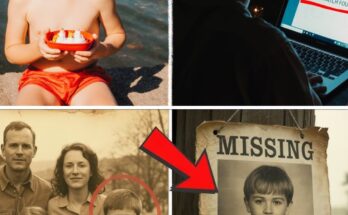On a golden late-summer afternoon in Boise, Idaho, the Moore family orchard hummed with wedding anticipation. Emma Moore, radiant in cream lace, stood ready to walk down the aisle, her smile tinged with the ache of an empty chair—her sister Rachel’s, lost to a fiery car crash 10 years earlier. Then, as soft piano notes played Rachel’s favorite Clair de Lune, a woman appeared on the gravel path, her face a haunting echo of the sister Emma buried. Clutching a rusted ballerina necklace, she whispered, “I’m sorry I missed the last 10 years.” Rachel was alive, and the truth she carried—of a twin, a sinister experiment, and a family’s betrayal—would unravel everything. This is the story of a sisterhood reclaimed and a secret that refused to stay buried.
The day of Emma’s wedding was picture-perfect, with wildflowers scenting the air and laughter spilling from a tented reception. At 29, Emma had built a life as a teacher, her warmth a beacon for her students, but the loss of Rachel at 19 had left a wound that never closed. Rachel, a nurse with dreams of saving lives, died in 2015, her car consumed by flames on a rural Boise road. Dental records and a partial DNA match confirmed her death, or so they thought. Emma carried the grief quietly, wearing Rachel’s memory like a second skin, her wedding day a bittersweet step forward.

about:blank
As guests mingled, the rustle of whispers broke the festive hum. A woman in a faded dress approached, her eyes heavy with a decade’s weight. Emma’s bouquet fell, her breath stolen. The woman was Rachel—same chestnut hair, same scar on her knee from a childhood bike fall. Gregory Moore, their father, a retired sheriff, pushed through, his voice sharp: “Rachel Moore is dead. I buried her.” But the woman held up a ballerina necklace, a gift from Emma the night before the crash. “You buried someone else,” she said. The world tilted.
Inside the Moore home, the wedding paused, guests scattered. Rachel sat at the kitchen table, her hands trembling as she recounted waking in a Montana clinic two years after her “death,” drugged and told she was Mara Whitmore, her memories erased. For years, she believed it, until a nurse’s forgotten yearbook showed her face with the caption: “Rachel Moore, voted most likely to save the world.” Memories flooded back—her mother’s cinnamon hugs, Emma’s laughter, a life stolen. She escaped, walking days to reach Boise, drawn to Emma’s wedding by a pull she couldn’t explain.
Gregory called the sheriff, demanding DNA tests. Emma sat frozen, clutching a photo strip of her and Rachel at a fair, cotton candy smudged on their faces. Rachel traced a faded sticker on her old bookshelf: “Private, Rages Only.” Her voice broke: “I missed Mom’s funeral. I didn’t know she was gone.” Their mother, Evelyn, died of cancer in 2019, a loss Rachel only now grieved. Emma asked, “Who kept you away?” Rachel’s eyes darkened. “A man in a green jacket. He said, ‘You died. That’s all you need to know.’”
The next morning, a photo slipped under the door—a hospital bed, Rachel, dated 2017. On the back: “You were never supposed to come back.” Gregory found his office disturbed, his pistol missing. Rachel’s nightmares grew—mirrors with unblinking reflections, antiseptic smells no one else noticed. An anonymous email arrived, a medical file stamped “Deceased” under Rachel’s name, signed by Dr. Victor Lang, the coroner who certified her death. It detailed sedatives, memory suppression, and a chilling note: “We buried the wrong girl.”
Emma and Rachel drove to Kalispell, Montana, where Rachel escaped. The clinic was gone, razed to a barbed-wire field, but a mailbox held a photo of Rachel and nurse Clara Mendes, with Dr. Lang in the background. A note read: “Kalispell wasn’t the beginning. Start at the lake.” At Flathead Lake, they found ruins of Whisper Lake House, a burned-out psychiatric facility. Rachel uncovered a tin box with Clara’s nametag, a cassette, and a photo of a girl identical to her. The tape played Clara’s voice: “They called you Jane Doe, Rachel. There’s another girl, Echo, your double. Project Mirror swapped lives, controlled memories. You knew too much. Go to Elkhorn.”

In Boise, Emma found a locker at the Greyhound station containing Project Mirror documents, a red baby blanket Rachel recognized, and photos of twin girls: “Subject A, Rachel Moore; Subject B, Echo.” Gregory confessed: Project Mirror was a classified program monitoring twins, Rachel raised normally, Echo controlled. Their mother fought to free them, but the state claimed Echo. The car crash was staged, Echo killed to erase Rachel, who’d seen her twin’s file. Gregory signed Echo’s termination, believing it protected Rachel.
Rachel drove to Elkhorn, a Montana ghost town, finding a church with a trapdoor marked by Project Mirror’s logo. Below, a medical chamber held a video of two toddlers—Rachel and Echo—playing, and a voice: “You were the mistake, Rachel. Echo was meant to replace you.” Dr. Lang appeared, admitting Echo’s defiance led to the project’s end. Rachel fled, collapsing into Emma’s arms back in Boise: “Dad signed my death order.”
Clara, found in an Oregon shelter, confirmed Echo died saving Rachel, stealing a car to escape but crashing in flames. Rachel shared their story with journalist Helen Stokes. The article, “She Was Buried 10 Years Ago, Then Walked Into Her Sister’s Wedding,” sparked outrage. Lang was arrested, Gregory vanished into obscurity, and Rachel built a memorial for Echo: “She lived unseen. She died with courage.”
Rachel and Emma moved to a modest Boise rental, planting a garden, adopting a cat named Echo. Rachel became a trauma counselor, writing The Girl Who Was Buried Twice, a bestseller of raw heart. She kept a cassette of her and Echo’s third birthday, their giggles a reminder of a twin she never knew but always felt. At Echo’s grave, Rachel read a letter: “You died so I could live. I’ll live twice as hard, for both of us.” Emma stood beside her, their bond a lifeline. Under the orchard trees, Rachel whispered, “You’re never missing again, Echo.”


